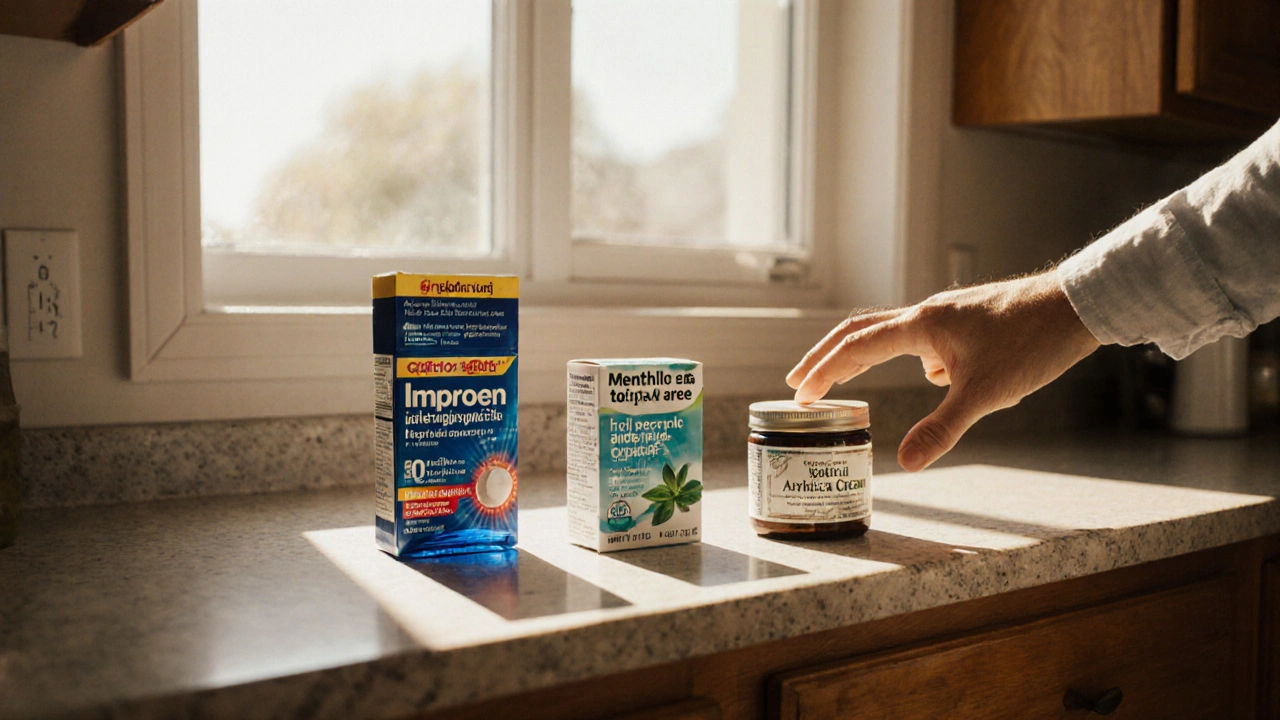Topical Pain Relief Selector
What type of pain are you experiencing?
Do you have any medical conditions or allergies?
When it comes to fast‑acting relief for joint and muscle pain, Emulgel is often the first name that pops up. Emulgel is a topical formulation that delivers diclofenac - a non‑steroidal anti‑inflammatory drug (NSAID) - directly to the skin, bypassing the digestive system. While many users swear by its quick soothing effect, a growing list of alternatives promises similar or even better outcomes with different safety profiles. This guide pits Emulgel against the most popular over‑the‑counter (OTC) options, helping you decide which product fits your pain‑management style.
Quick Take
- Emulgel provides rapid pain relief for localized inflammation, but may cause skin irritation in sensitive users.
- Ibuprofen gel (Ibuprofen Gel) works similarly but is often cheaper and has a milder scent.
- Ketoprofen gel (Ketoprofen Gel) penetrates deeper, making it a top pick for chronic joint pain.
- Capsaicin cream (Capsaicin Cream) targets nerve pain and can be used long‑term, though it brings a warming sensation.
- Lidocaine patches (Lidocaine Patch) are best for post‑surgical or neuropathic pain, offering numbing without anti‑inflammatory action.
How Emulgel Works
Diclofenac, the active ingredient in Emulgel, blocks cyclooxygenase (COX) enzymes that produce prostaglandins - the chemicals that cause pain, swelling, and fever. By applying the gel to the skin, the drug concentrates where it’s needed most, achieving therapeutic levels within 30‑45 minutes. Its formulation includes a water‑in‑oil emulsion (hence the name “Emulgel”), which enhances absorption while keeping the texture non‑greasy.
Topical Alternatives at a Glance
| Product | Active Ingredient | Typical Strength | Onset of Relief | Best For | Common Side Effects |
|---|---|---|---|---|---|
| Emulgel | Diclofenac | 1% (10mg/g) | 30‑45min | Acute sprains, tendonitis | Skin irritation, rare GI upset |
| Ibuprofen Gel | Ibuprofen | 5% (50mg/g) | 45‑60min | Mild muscle aches | Redness, mild burning |
| Ketoprofen Gel | Ketoprofen | 2.5% (25mg/g) | 20‑30min | Chronic osteoarthritis | Itching, occasional rash |
| Capsaicin Cream | Capsaicin | 0.075% (0.75mg/g) | 2‑3hours (build‑up) | Neuropathic pain, back pain | Burning, tingling |
| Lidocaine Patch | Lidocaine | 5% (50mg/patch) | 15‑30min | Post‑operative, nerve pain | Local numbness, rare allergy |
| Oral Diclofenac | Diclofenac | 50mg tablet | 1‑2hours | Systemic inflammation | GI ulcer, cardiovascular risk |
| Paracetamol (acetaminophen) | Paracetamol | 500mg tablet | 30‑60min | Fever, mild pain | Liver toxicity at high dose |
When Emulgel Beats the Rest
If you need fast, localized relief without swallowing pills, Emulgel often comes out on top. Its anti‑inflammatory action is stronger than ibuprofen gel, making it a go‑to for swollen joints. Athletes recovering from a sprained ankle or someone with a painful bursitis may prefer the gel’s quick penetration.
However, the gel can sting on broken skin and isn’t ideal for people with a history of NSAID‑related ulcers. In such cases, switch to a non‑NSAID option like lidocaine patches or capsaicin cream.

Why You Might Choose an Alternative
Ibuprofen Gel is usually cheaper and has a milder scent, making it a solid choice for everyday muscle soreness. Ketoprofen Gel penetrates deeper, so chronic joint pain patients often report longer‑lasting comfort.
For nerve‑related discomfort, Capsaicin Cream works by desensitizing pain receptors after a few applications. If you dislike the warming sensation, a Lidocaine Patch offers pure numbing without any anti‑inflammatory effect, perfect after surgery.
When systemic inflammation is the culprit (e.g., rheumatoid arthritis), oral diclofenac or a standard NSAID tablet may be more effective than any topical option because the drug reaches the entire body.
Safety Considerations & Contraindications
All NSAID gels share a risk of skin irritation, especially on sensitive or compromised skin. Apply a thin layer and avoid open wounds. If you have a known allergy to diclofenac, ibuprofen, or any topical ingredients, skip the gel altogether.
Lidocaine patches should not be used on broken skin or in excessive quantities, as systemic absorption can lead to dizziness. Capsaicin users must wash hands thoroughly after application to prevent accidental eye contact.
People with cardiovascular disease, chronic kidney disease, or a history of gastric ulcers should consult a doctor before starting any NSAID‑based product, even topicals.
Practical Tips for Getting the Most Out of Your Gel
- Clean and dry the affected area before applying; moisture can dilute the gel.
- Rub in a gentle, circular motion for 30seconds to boost absorption.
- Wash your hands after use unless the hands are the treatment site.
- Limit use to 3‑4 times a day; exceeding this may increase skin irritation.
- Combine with gentle stretching or physiotherapy for best functional recovery.
If you’re rotating products, give each a 24‑hour wash‑out period to evaluate side‑effects accurately.
Bottom Line
Emulgel shines when you need rapid, potent anti‑inflammatory action on a specific spot. Alternatives like ibuprofen gel or ketoprofen gel offer comparable relief with different price points and skin‑tolerance profiles. For nerve‑pain or post‑surgical numbness, look beyond NSAIDs to capsaicin or lidocaine. Always weigh your medical history and pain type before reaching for the next bottle.
Frequently Asked Questions
Can I use Emulgel on a fresh wound?
No. Applying any NSAID gel to an open wound can delay healing and cause irritation. Stick to clean, intact skin.
How does Emulgel compare to oral diclofenac?
Topical Emulgel provides localized relief with far less systemic exposure, meaning lower risk of stomach or heart issues. Oral diclofenac works throughout the body and is better for widespread inflammation.
Is it safe to combine Emulgel with other NSAID creams?
Generally not recommended. Doubling up on NSAIDs can increase skin irritation and systemic absorption, raising the risk of side‑effects.
What’s the best alternative for chronic knee osteoarthritis?
Ketoprofen gel is often favored because it penetrates deeper and lasts longer. Pair it with physiotherapy and, if needed, an oral NSAID under a doctor’s supervision.
Can I use Emulgel while pregnant?
Diclofenac is generally avoided during pregnancy, especially in the third trimester. Talk to your obstetrician before using any NSAID gel.


S. Davidson
Alright, let's set the record straight-Emulgel isn’t some miracle cure, it’s just a diclofenac delivery system with a fancy marketing name. It does the job for acute inflammation, but you’ll still run into the classic NSAID side‑effects if you’re not careful. Think of it as a localized version of the oral pills you’ve likely been warned about since high school. Bottom line: use it wisely, or you’ll be swapping one problem for another.
Haley Porter
From a mechanistic standpoint, the pharmacodynamics of diclofenac in Emulgel hinge on COX‑1/COX‑2 inhibition, culminating in attenuated prostaglandin synthesis. This biochemical cascade translates to reduced nociception at the peripheral site, a principle echoed across NSAID therapeutics. Yet, juxtaposing this with the analgesic latency of capsaicin, which modulates TRPV1 receptors, reveals divergent pathways to pain mitigation. Ultimately, the clinician's choice should reflect both pharmacokinetic profiles and patient-specific risk stratifications.
Samantha Kolkowski
i think Emulgel works pretty good for quick relief but i also read that it can sting if you have sensitive skin. maybe try a smaller amount first, test it on a spot before full applcation. also dont forget to wash your hands after unless thats the area you treat.
Nick Ham
Emulgel is just another NSAID gel-nothing special, just cheap hype.
Jennifer Grant
When one embarks upon the odyssey of chronic musculoskeletal discomfort, the sheer tapestry of therapeutic options unfurls before the weary traveler, each thread woven with its own cultural and historical resonance. Emulgel, bearing the stoic emblem of diclofenac, invites us into a legacy of Western pharmaco‑logic where inflammation is tamed through COX inhibition, a paradigm seated firmly within the annals of 20th‑century biochemistry. Yet, the ancient ayurvedic practitioners would whisper of herbal balms, their aromatic constituents coaxing the body into harmonious equilibrium without the overt antagonism of synthetic molecules. In the bustling bazaars of modern medicine, Ibuprofen Gel emerges as a humble cost‑effective sibling, its modest scent and broader accessibility making it a staple for the everyday aches of the working class. Ketoprofen Gel, by contrast, dons the mantle of the elite, its deeper dermal penetration likened to a seasoned diplomat navigating the intricate corridors of chronic osteoarthritic pain. Capsaicin Cream, awash in the fiery spirit of chilies, offers a paradoxical comfort-its initial burning giving way to a dulled perception of neuropathic torment, a testament to the body's capacity for adaptation. Meanwhile, the Lidocaine Patch, a silent sentinel, numbs the afflicted region, an unsung hero for post‑surgical convalescents seeking solace without the systemic ripple of NSAIDs. One must also consider the sociopolitical undercurrents that shape drug availability; in certain regions, regulatory tides may bar the entry of certain formulations, compelling patients to seek alternatives born of necessity rather than preference. Moreover, the ecological footprint of manufacturing synthetic gels versus sourcing botanical extracts cannot be ignored, for the health of the planet is inexorably linked to the health of its denizens. The clinical practitioner, therefore, stands at the crossroads of efficacy, safety, economics, and ethics, tasked with guiding the patient through this labyrinthine selection. Personal anecdotes abound-my neighbor, a retired carpenter, swore by Emulgel’s rapid relief after a sprained wrist, while his sister, an avid yogi, found solace in the slow, steady embrace of ketoprofen. Such narratives, though anecdotal, underscore the profound individuality of pain perception and response. In the final analysis, the decision matrix must incorporate the patient’s medical history, tolerance for side‑effects, and even cultural comfort with certain modalities. As we navigate this mosaic of possibilities, let us remain steadfast in our commitment to evidence‑based practice while honoring the lived experiences that color each therapeutic journey.
Kenneth Mendez
Look, the big pharma push behind Emulgel is obvious-they want you glued to their gel tubes while the real cure is hidden.
Gabe Crisp
It's morally reprehensible to trust a product designed by corporations that profit off our pain; we should seek natural alternatives.
Paul Bedrule
One could argue that Emulgel represents a microcosm of modern analgesic philosophy-transient relief manifested through chemical modulation of nociceptive pathways.
yash Soni
Great, another gel.
Emily Jozefowicz
Honestly, if you’re looking for a quick fix, Emulgel does the job-but don’t forget the basics: rest, ice, and proper stretching.
Franklin Romanowski
I totally get how frustrating it can be to pick the right topical. I’ve tried Emulgel for my tennis elbow, and while it helped with the soreness, I found that rotating with a gentle ibuprofen gel kept the irritation down. Remember to give your skin a break between applications; it can make a big difference.
Brett Coombs
All this talk about gels is just a distraction. The real issue is that the government lets these chemicals run wild without questioning the long‑term effects.
John Hoffmann
While the user above raises concerns, it's important to note that the peer‑reviewed literature consistently documents the safety profile of topical diclofenac when used as directed. Misuse, however, can lead to the very side‑effects you're wary of.
Shane matthews
Thanks for the thorough breakdown it really helps those of us new to this stuff
Rushikesh Mhetre
Hey, just a heads‑up: always apply a thin layer and massage it in for 30 seconds-this really boosts absorption! Also, keep a log of your usage so you can spot any patterns of irritation early on; consistency is key!!!
Sharath Babu Srinivas
Great tip! 😊 Remember to wash your hands after applying, unless your hands are the target area. 👍
Halid A.
In reviewing the comparative data, it is evident that Emulgel offers a rapid onset of action suitable for acute sprains, whereas ketoprofen gel provides superior durability for chronic joint degeneration. Consequently, clinical decision‑making should align product selection with the pathology's temporal characteristics.
Barry Singleton
Sure, the data says Emulgel is fast, but you’ll still end up buying more of it because you’ll never be satisfied.